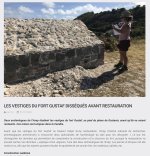JEK
Senior Insider

REMAINS OF FORT GUSTAF DISSECTED BEFORE RESTORATION
by V.A 07/01/2020
Two archaeologists from I'Inrap (Institut national de recherches archéologiques préventives) study the remains of Fort Gustaf, at the foot of the Gustavia lighthouse, before they have been restored. These ruins are unique in the Caribbean.
Before the remains of Fort Gustaf were restored, the Inrap (National Institute for Preventive Archaeological Research) commissioned two specialists in building archeology to decipher them. "The goal is to record the data that allow us to understand the construction and structure of the fort, since the restoration will then hide this data," said Anne Jegouzo, one of the two archaeologists at Inrap. The stones and bricks have been laid bare, so that experts can study the skeleton of this ancient fort, the materials used, etc.
Swedish construction
from the end of the 18th century
A first week at the beginning of March was devoted to the magazine and the kitchen, a second work session will start from July 6 on the other remains of this fort. “A small battery had been built here by the French in the 17th century. When the Swedes arrived in 1785, they built Fort Gustaf on this old fort. There were two buildings under the current weather station, and today there remains the cistern, the gatehouse, the kitchen and the powder magazine. Below, a barracks made it possible to house around thirty soldiers, ”describes Anne Jegouzo. "At the same time, they set up Fort Karl (above Shell Beach, note), which is more of a battery than a fort, and Fort Oscar (the gendarmerie, note). But it is Fort Gustaf that is the most important. Gustavia was a free port which therefore needed real protection, especially since European conflicts had repercussions in the Caribbean. Besides, the English invaded Saint-Barthélemy for a few years. Forts like those of Gustavia are found on most of the Caribbean islands, but those of Saint-Barthélemy are unique because they are the only ones to have been built by Scandinavians. "The architectural elements are potentially dissimilar, the construction method differs. We see it for example in the way of cutting stones and mounting walls; the French remains are made of rectangular stones, alternating between short and long stones. The Swedish walls you can see in Gustavia are made of cubic stones only. "
During this archaeological research, "we would like to find old elements", admits Anne Jegouzo. "However, there is a good chance that the French fort is a light construction, made of earth or wood, and therefore that nothing can be found. But for now, Inrap is studying the different layers of plaster and mortar, to discover the framework of the constructions. "The powder magazine was built on an old redoubt, that is to say a fortification zone which serves as a launch pad. I would like to trace it ... "
Inside the powder magazine, stones and bricks have been removed from successive coatings. On the ground appears a paved part, another in mortar. The lower part of this space is made of volcanic stone, "some come from Saint-Barthélemy, others come from elsewhere. This building that was used to store the powder had to have thick walls, and holes in the walls were used to maintain air circulation. "The ceiling is a red brick vault," the source of which we would like to determine ... Once the fieldwork is complete, a study will be carried out within Inrap in Guadeloupe, to analyze the mortars and rocks. In the wall, we see the use of different mortars, which may indicate that the powder magazine was built on an already existing wall. Perhaps that of the initial redoubt of Fort Gustaf?




